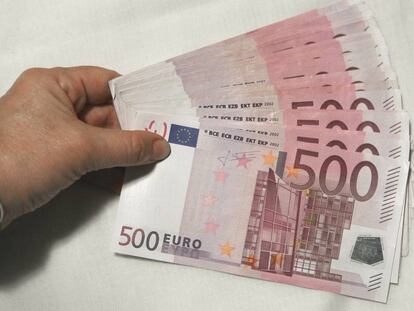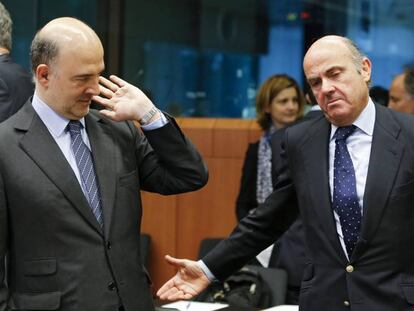Brussels warns Spain it will keep a close eye on its high debt levels
European Commission notes that Madrid must continue to enforce strict fiscal policy after 2018
The European Commission is warning Spain, which is currently in the corrective program of the Stability and Growth Pact, that austerity will not end with the conclusion of the Excessive Deficit Procedure (EDP), a package of measures for member states whose public accounts are out of control.

In a recently released report commenting on the Spanish government’s latest Stability Plan, Brussels explains that even though Spain is scheduled to emerge from the EDP in 2018, it would still have to meet debt reduction criteria for three additional years.
The problem is that there are several countries in Europe dealing with high debt levels, and politically it would be difficult to apply corrective measures to all of them.
Other EU member states also have debt-to-GDP ratios of around 100%, while Italy clocks in at 130%
The Spanish government believes economic recovery will bring the public deficit down below 3% of GDP by next year. Once that happens, Spain will drop out of the EDP, a disciplinary program imposed by Brussels on countries that have trouble keeping their finances under control.
As was the case with Portugal recently, the administration of Spanish Prime Minister Mariano Rajoy would then have free rein to design its own policies and go back to doing things like lowering taxes immediately before a general election.
But in its overview of Spain’s Stability Plan, which Madrid submitted earlier this year, the Commission warns that European oversight of Spain’s expenditure will not end with its departure from the EDP.
Brussels’ analysis concludes that because Spain’s projected debt-to-GDP ratio for 2018 is 98.5%, which exceeds the established target of 60%, the country would still be subject to arrangements in order to meet desired debt levels for three years following departure from the EDP.
The Spanish government trusts believes economic recovery will bring public deficit down below 3% of GDP by next year
European treaties stipulate that member states with debt in excess of 60% of GDP must shave off a twentieth part of the excess every year. Since Spain is 40 points above target, it would have to reduce it by two GDP points every year, a demanding goal that would require a strict and sustained containment of public spending.
The evolution of the debt-to-GDP ratio depends on three items: the accounts balance, either a deficit or a surplus; interest rates; and economic growth. If the economy experiences substantial growth and rates remain low, as has been the case to date, debt levels can be brought down even with a very high deficit of around 4% of GDP.
Under these conditions of high growth and low rates, Spain’s debt-to-GDP ratio dropped from 100.4% in 2014 to 99.4% at the close of 2016, even though, in absolute terms, debt itself grew from €32.3 billion in 2015 to €33.1 billion in 2016.
But these conditions will not always be in place. At some point, the European Central Bank will stop buying debt, and interest rates could spike again. Analysts also expect economic growth to slow.
All of this requires balancing the accounts, a goal that is increasingly harder given the pressure on pension payments from an ageing population.
Other EU member states also have debt-to-GDP ratios of around 100%, while Italy clocks in at 130%. This makes it difficult to place so many countries under a specific corrective program. For now, the report issues little more than a warning.
English version by Susana Urra.
Tu suscripción se está usando en otro dispositivo
¿Quieres añadir otro usuario a tu suscripción?
Si continúas leyendo en este dispositivo, no se podrá leer en el otro.
FlechaTu suscripción se está usando en otro dispositivo y solo puedes acceder a EL PAÍS desde un dispositivo a la vez.
Si quieres compartir tu cuenta, cambia tu suscripción a la modalidad Premium, así podrás añadir otro usuario. Cada uno accederá con su propia cuenta de email, lo que os permitirá personalizar vuestra experiencia en EL PAÍS.
¿Tienes una suscripción de empresa? Accede aquí para contratar más cuentas.
En el caso de no saber quién está usando tu cuenta, te recomendamos cambiar tu contraseña aquí.
Si decides continuar compartiendo tu cuenta, este mensaje se mostrará en tu dispositivo y en el de la otra persona que está usando tu cuenta de forma indefinida, afectando a tu experiencia de lectura. Puedes consultar aquí los términos y condiciones de la suscripción digital.
More information
Archived In
Últimas noticias
Trump followed CIA recommendation to hand power to Delcy Rodríguez due to risk that Machado would not control the army
The Motherwell painting that Franco wanted to hide from view
Mexico seeks to shore up its defenses following US incursion in Venezuela
Hope gives way to uncertainty among Venezuelan exiles in the US after Maduro’s capture
Most viewed
- Alain Aspect, Nobel laureate in physics: ‘Einstein was so smart that he would have had to recognize quantum entanglement’
- Alvin Hellerstein, a 92-year-old judge appointed by Bill Clinton, to preside over Maduro’s trial in New York
- Cuba confirms death of 32 of its citizens in the US attack against Venezuela
- Gilles Lipovetsky: ‘If you want to live better and fall in love, take Prozac, don’t look to philosophy’
- Why oil has been at the center of Venezuela-US conflicts for decades











































